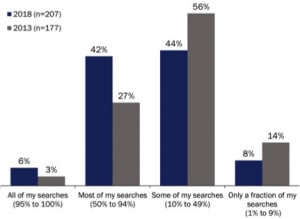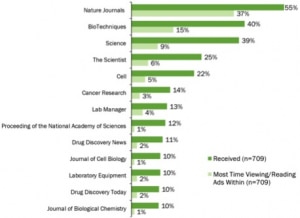The Content & Media Preferences of Life Scientists
Advertising to Inform & Influence
BioInformatics, Inc. has been tracking life science advertising for almost two decades. Our latest report, Advertising to Life Scientists, explores how scientists’ content and media preferences can inform the advertising strategies of suppliers.
On an almost daily basis, scientists are inundated with life science ads, images, discounts, and promotions. Suppliers who understand when and why scientists find advertising useful have a greater opportunity to inform and influence potential customers across multiple media.
Life science suppliers have an almost endless array of choices as to where to advertise their products and services. Scientific publishers are launching new titles (mostly online), adapting their content, and changing their format to attract a body of well-defined, loyal readers in an effort to attract advertising dollars. Ultimately, the most successful publications, and therefore the most effective advertising venues, will be those that provide the greatest value to their readers.
Advertising is necessary to create brand awareness and reinforce product differentiation and brand recognition. But life scientists are increasingly sophisticated consumers and media savvy thus reinforcing the need for more mindful and integrated marketing campaigns that blend online, mobile, social – and yes, – print channels.
Content
Advertising encompasses more than ads in the traditional sense of paid, purely promotional announcements designed to call attention to products, services or needs. Advertising, as defined in this study, also encompasses a wealth of information-rich, sponsored content, both online and in print. It must be clear to the reader that the content is sponsored to avoid potential conflicts regarding the editorial stance of a site or publication.
The goal of sponsored content, or native advertising, is to be relatively unobtrusive and provide valuable information within feeds, sites, and channels where the audience is already engaging. The supplier’s content is not directly showcasing their brands, but instead, putting a spotlight on their brand’s relationship with the broader scientific community or a particular field of research. Ideally, this type of content is then shared among the audience and engages them inside their own community.
Search
Marketers will not see the benefits of their content strategy unless scientists can find and engage with it. The extensive use of general search engines to look for product information reinforces the need for life science suppliers to actively employ search engine optimization (SEO) as part of their online marketing strategy. SEO takes into consideration how search engines work, what combination of terms are typically used for search as well as an awareness of which search engines are preferred by their target audience.
Product name, technique and application are the most frequently used search terms overall. Effective branding through advertising— associating a specific name to a product in a market place where there are many competing products to accomplish the same task— is more important than ever to make sure your product is recognized as signal, not noise.
Search Advertising
Paid search advertising is a critical component of an integrated advertising program. This is especially true for new and smaller suppliers that often lack a dedicated team needed to produce the volume of content required to appear in high in the organic search results. Paid search ads reflect well on a company’s brand because an ad’s rank is not solely based on the amount that was bid – Google and other search engines also look at the advertiser’s quality score, which is a measure of how relevant the keywords are to the ad’s text and to what a user is searching for. The challenge will be— and remains —how to increase their accuracy in light of ever changing search algorithms and thus their perceived utility from the customer’s perspective. People who see paid search ads are generally searching for a product or service. Those who click on an ad are not mindlessly searching the web, but rather, are highly likely to be fairly well advanced in the course of their “customer journey.” Finally, search engines provide marketer’s with detailed analytics to enable ad campaigns to be more efficient and continuously refine the keywords and message.
Display Advertising
Life scientists agree that display advertising is effective in generating product and brand awareness. They recognize that advertising is a communication channel that creates and supports their awareness for the brands, products and services that they need to achieve their research objectives. Digital display ads are usually more visually appealing than their paid search counterparts, and can be just as effective in driving traffic. A display advertising campaign must begin with clear, measurable objectives. For example, the number of impressions achieved may be a useful metric for a brand awareness campaign, but display ads meant to influence on sales or produce leads should be judged on click-through rate and/or conversions. Display ads can be both targeted and re-targeted at a very granular level. Marketers, therefore, must have equally granular information on customers’ research interests, techniques in use, age, gender, and reading preferences in addition to general demographics such as market segment and region. Life science suppliers are experimenting with a variety of new display ad formats that go beyond the traditional banner ad. In their zeal to be creative and be seen, marketers need to take care not to be so innovative that their ads become annoying distractions.

Frequency of Scientists’ Clicking on Display Ads
Personalization
Digital advertising provides unprecedented opportunities to personalize advertisements and the landing pages to which they connect. Consumer brands are able to deliver targeted ads not just based on the stated need, but also, based on exact geographic location, advanced demographic information, specific niche interest, buying intent, and other behavioral patterns (purchase history, political leanings, web page visited, etc.)
Scientists also realize the value of the information that they divulge to vendors, and ad-blocking software—in addition to other technologies—enables them to challenge vendors for control of their personal information. Suppliers must constantly assess how best to receive permission from scientists in order to use their information in the development of more personalized advertising formats. The answer lies in the quality and personalization of the landing page tied to the ad rather then sending them to an impersonal company homepage. An ideal landing page will contain a headline uses message that closely matches the ad’s keywords, easy-to-read copy, a short gravity form, and a single call to action. This approach results in an improved customer experience, a greater willingness to share personal information to receive even more personalization, and higher Google rankings.
Print advertising remains alive and well in 2018. The ubiquity of digital media has given print a new lease on life. Studies have shown that print ads make a better impression than digital ones. Numerous studies have indicated that people process print content with greater engagement and focus and a deeper emotional response, than they do content viewed on a screen. It has also been suggested that digital content tends to be scanned whereas paper-based reading is slower and more deliberate, resulting in higher levels of comprehension. Print is still a valuable option when in direct contact with customers such as at a scientific conference.

Print Publications Read By Scientists
Storytelling
Advertisers are increasingly using advertising across all media to engage in “storytelling”. Stories—particularly specific, highly detailed stories evoke an emotional response. Storytelling can be leveraged when they highlight the shared experiences of the target audience. Shared experiences can shape one’s perception of a product. An individual’s opinion of a product and value it provides doesn’t just come from personal experience but also what others think about it through shared memories – whether they be the drudgery of manual pipetting or making competent cell or the thrill of a new discovery. Digital advertising can deliver highly immersive and engaging ad formats are to support brand storytelling across multiple media and devices. So-called “programmatic creative” allows messaging to be sequenced so it takes the readers or viewers on a journey. Instead of serving the same ad over and over, programmatic creative lets brands convey a story that is relevant and updated.
Match Advertising Content With Customer Needs
Make it easy for this most skeptical of audiences to find the information they need to make a decision. Use advertising to create awareness at the beginning of the purchasing cycle. Assure that credible, information-rich content, including sponsored content, is available and easily accessible as customers travel down the path of their buying journey. The closer they get to a purchasing decision their demand for information will both broaden and deepen. Advertising—both print and online—is the tip of the spear for integrated, content-driven marketing campaigns.
To execute a successful advertising campaign, it is essential that life science suppliers be discerning in their advertisement placements digitally and in print. Vendors that place their ads in print and through online channels that scientists perceive as trusted and welcome sources of information and design their ads to contain or link to valuable information will have greater success with their advertising strategies. This report is designed to help suppliers critically examine their current print and online advertising initiatives. It will also help them to identify specific steps related to ad creation, design, placement, and tracking where optimization may help improve their return on investment—based upon an understanding of how scientists are exposed to and react to life science ads.




